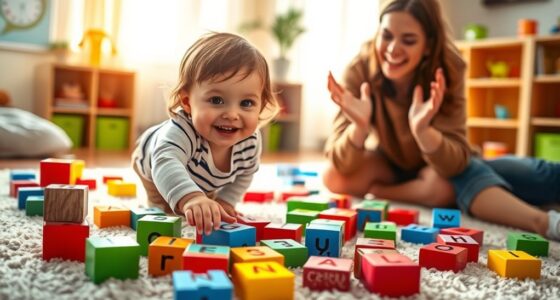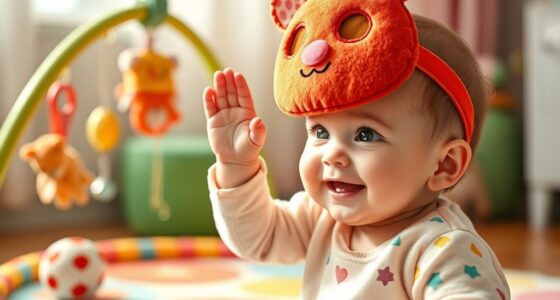Engage your baby’s developing mind with Peek-a-Boo, which promotes object permanence and memory. Music enhances cognitive growth, with rhythm aiding mathematical skills. Stimulate senses with sensory play, fostering cognitive, physical, and emotional development. Shape sorting builds spatial awareness, math skills, and problem-solving abilities. Creative storytelling boosts language, imagination, and literacy skills early on. These activities are essential for overall infant development, nurturing neural pathways, motor skills, and brain growth. Start these fun and educational brain games with your baby to support their cognitive, physical, and emotional growth right from the beginning. Learn more about the benefits these games offer for your baby’s development.
Key Takeaways
- Peek-a-Boo fosters object permanence and memory.
- Musical experiences enhance cognitive and mathematical skills.
- Sensory play stimulates brain development and motor skills.
- Shape sorting games improve spatial awareness and problem-solving.
- Creative storytelling enhances language development and imagination.
Peek-a-Boo Magic
Engage your little one's developing mind with the magical game of Peek-a-Boo. This fun game goes beyond simple amusement, playing an important role in your baby's cognitive development.
By playing Peek-a-Boo, you're helping your baby grasp the concept of object permanence, a key milestone typically reached around 4-7 months of age. Through this interactive play, babies start understanding that even if something is out of sight, it still exists.
Peek-a-Boo also supports memory milestones in babies. By repeatedly covering your face and then revealing it, you're aiding your baby's memory development. This game offers visual stimulation, encouraging babies to focus and engage actively.
In addition, Peek-a-Boo promotes social interaction and emotional growth as your little one experiences joy and surprise during the game. So, next time you play Peek-a-Boo with your baby, remember that you aren't just having fun – you're also nurturing their developing mind.
Musical Moments
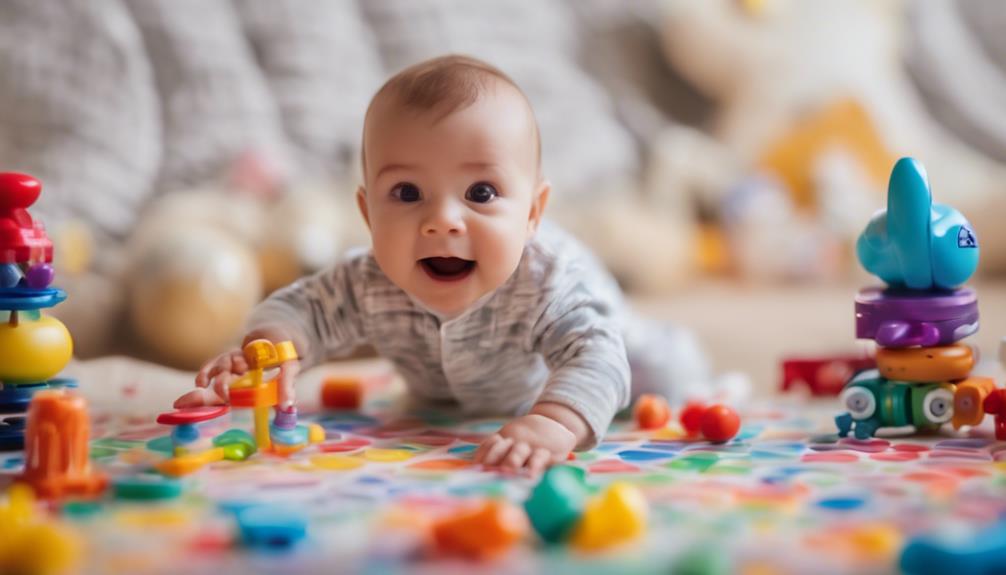
How can musical moments benefit your baby's cognitive development?
Introducing your baby to musical experiences from an early age can have a profound impact on their cognitive growth. Exposing babies to music helps them understand rhythm, which in turn benefits their mathematical skills.
Dancing with your baby not only creates joyful moments but also enhances their learning and cognitive development. Activities like bouncing and swaying to music can aid in their cognitive growth and overall development.
Starting music sessions from the newborn stage can be particularly beneficial for babies, as it becomes a familiar and comforting part of their daily routines.
Sensory Play Delights
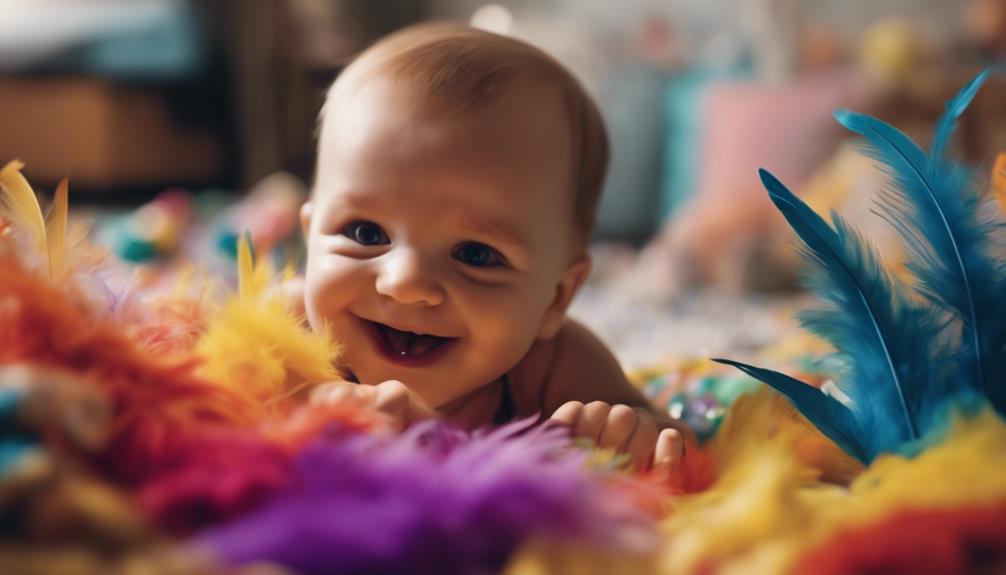
Introducing your baby to sensory play delights can stimulate their senses and foster cognitive, physical, and emotional development. Sensory play, which involves activities like touching different textures, listening to sounds, and exploring with their mouths, is essential for your baby's growth.
Engaging in sensory play not only promotes brain development by stimulating neural pathways but also helps in developing cognitive skills, language abilities, and social interactions. According to child development experts, sensory experiences play an important role in building fine and gross motor skills, supporting physical development.
Additionally, these activities have been shown to have a calming effect on babies, reducing stress and promoting relaxation. Dr. Smith, a pediatrician specializing in early childhood development, emphasizes, 'Sensory play is crucial for the overall development of infants as it enhances their cognitive, physical, and emotional well-being.'
Therefore, incorporating sensory play into your baby's routine can have numerous benefits that contribute to their overall growth and development.
Shape Sorting Fun
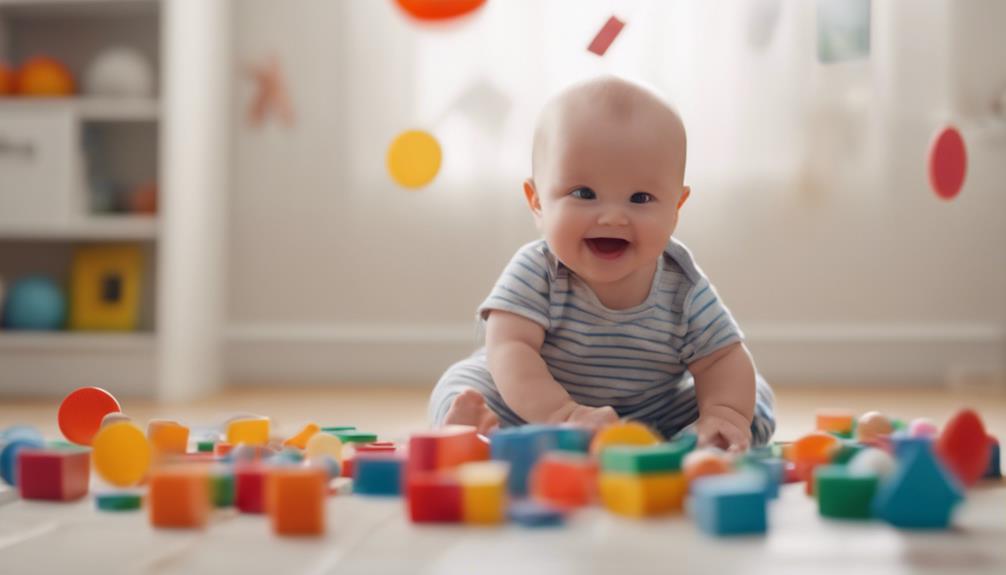
Shape up your baby's cognitive skills with some entertaining shape sorting fun! Shape sorting games aren't just enjoyable; they also play an essential role in enhancing your baby's spatial awareness and mathematical skills.
By engaging in hands-on play with building blocks, your little one can develop a better understanding of volume, distance, and structures. These activities introduce complex math concepts such as geometry and patterns in a playful manner.
As your baby engages in shape sorting, they aren't just playing; they're actively stimulating their cognitive development. According to child development experts, shape sorting fun promotes problem-solving skills and critical thinking in young children.
Creative Storytelling
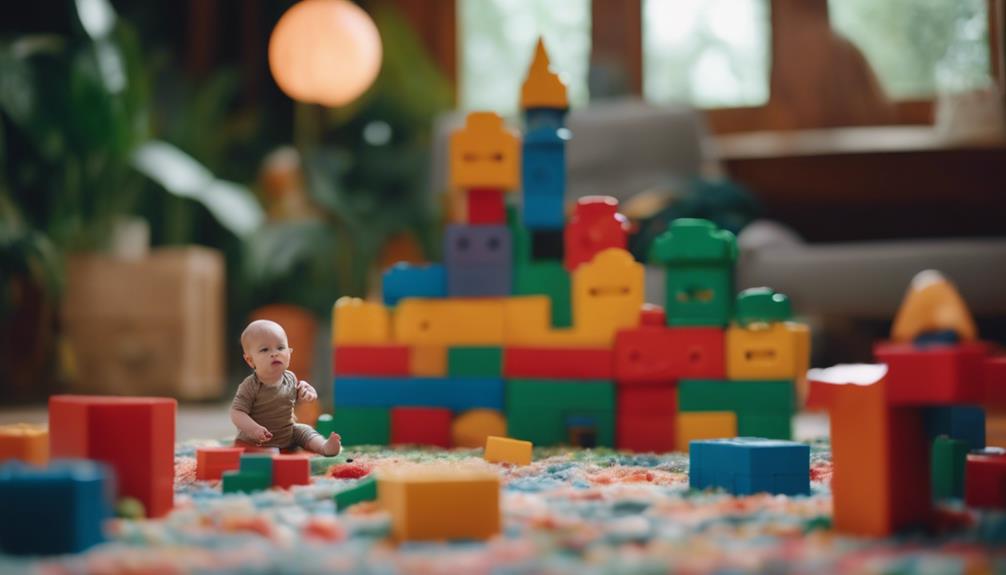
Enhance your baby's language development and imagination through the engaging practice of creative storytelling. Creative storytelling not only entertains but also plays an important role in your baby's cognitive development.
By using different voices and expressions while narrating stories, you can capture your baby's attention and enhance their cognitive skills. This interactive approach helps babies understand emotions, relationships, and the world around them, fostering early literacy skills.
Incorporating interactive elements, such as asking questions or encouraging participation, during storytelling sessions can further promote cognitive engagement. According to child development experts, storytelling with babies provides a valuable opportunity to introduce them to language in a fun and engaging way.
Reading books with your baby also supports their early literacy skills and instills a love for reading from a young age. So, make storytelling a regular part of your routine to stimulate your baby's imagination and language development effectively.
Frequently Asked Questions
What Kinds of Activities Help to Develop a Baby's Brain?
To help develop your baby's brain, engage in quality interactions with caregivers, play simple games like 'Wheres the cup?', encourage physical activities like tummy time and crawling, introduce music and rhythm activities, and read books with rhyming words to enhance cognitive skills.
What Are Memory Activities for Babies?
To boost your baby's memory, try engaging in interactive play, like 'Where's the cup?'. Reading rhyming books and playing with shape-sorting toys can also aid in cognitive growth. Foster social connections through games for best development.
How to Encourage Intelligence in Babies?
To encourage intelligence in babies, respond to their cues, engage in back-and-forth exchanges, play memory games like 'Wheres the cup?,' promote physical activity, and nurture emotional intelligence through positive interactions. Encouraging these activities supports cognitive and social development.
How Can I Stimulate My Baby's Cognitive Development?
To stimulate your baby's cognitive development, engage in quality interactions like responding to their cues, having conversations, and playing simple games. Encourage physical activities, initiate positive interactions, and keep engagement for social and emotional growth.
Conclusion
To sum up, baby brain games offer a valuable opportunity to stimulate cognitive development in young children. By engaging in activities such as peek-a-boo, musical moments, sensory play, shape sorting, and creative storytelling, infants can enhance their learning and problem-solving skills.
As one expert in child development noted, 'These interactive games not only entertain, but also promote brain growth and critical thinking abilities.'
So, next time you're looking for a fun and educational activity for your little one, consider incorporating these engaging games into your routine.


